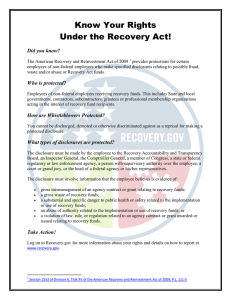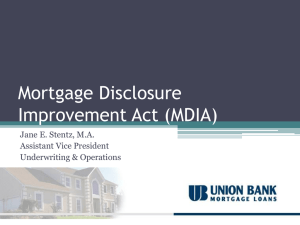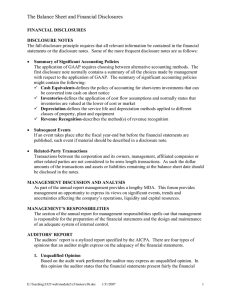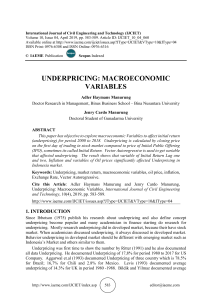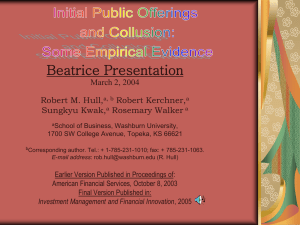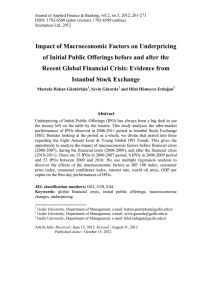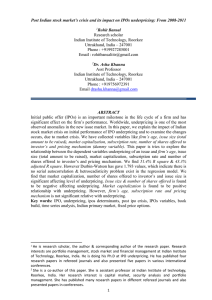Hard and Soft Information: Sudip Gupta and Ryan D. Israelsen
advertisement
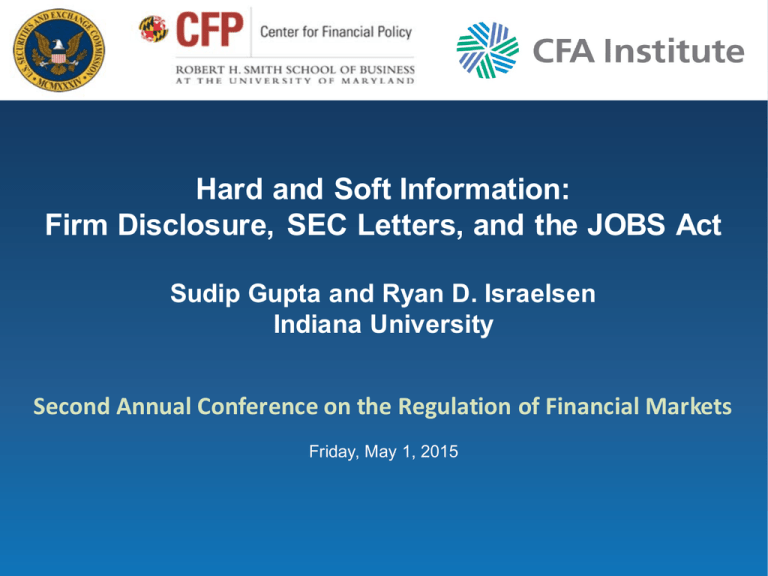
Hard and Soft Information: Firm Disclosure, SEC Letters, and the JOBS Act Sudip Gupta and Ryan D. Israelsen Indiana University Second Annual Conference on the Regulation of Financial Markets Friday, May 1, 2015 GAME CHANGER 2 THEME How does the Jumpstart Our Business Startups (JOBS) Act affect disclosures of hard and soft information and IPO outcomes? 3 MOTIVATION • Disclosure of information can: financial efficiency & the cost of capital (Edmans, et al. 2015, Easley and O’Hara, 2004) • Hard and Soft Information (Petersen, 2004) • Hard Information (e.g., accounting data) is Credible but Costly to Produce • Soft Information (e.g., discussion of accounting data) Less Costly to Produce but Less Credible • Optimal mix depends on relative tradeoffs • JOBS Act relaxed (binding?) constraints on disclosures of Hard Information change hard info. • Optimal mix Information • Market responds Firms should also change disclosures of soft QUESTIONS PREVIEW OF RESULTS 1. How do firms’ disclosures of hard and soft information differ under the JOBS Act? • Reduction in disclosure of hard information • Change in disclosure of soft information 2. How does the information produced by the SEC change? • Produces more information • Soft information is more uncertain and negative in tone 3. How does the market respond? • Underpricing – Only soft info: firm & SEC • Informed Trading – both hard and soft info. • Liquidity – Both hard and soft info. 4. What are the benefits of optimal disclosure of soft information? • Relative to a counterfactual, underpricing reduced by 2.7% • Relative to a counterfactual, Bid-Ask spreads reduced by 1 cent 5 JOBS ACT (APRIL 5, 2012) • Aim: Improve access to the public capital markets for Emerging Growth Companies (EGCs) • Title I: • Reduces financial disclosures • 2 years (vs. 3) of audited financial statements • 3 years (vs. 5) of selected financial data • Reduces disclosure of executive compensation • Compensation of 3 (vs. 5) key executives • May omit a written discussion • Allows the use of private accounting standards following IPO • Confidential Submission Process (and possibly withdrawal) • Testing the Waters • Exemption form internal controls audit 6 LITERATURE • Disclosure and Efficiency: • Verrecchia (2001), Dye (2001), Easley and O’Hara (2004), Petersen (2004), Edmans, Heinle, and Huang (2013), … • Impact of JOBS Act: • Dambra, Field, and Gustafson (2014), Chaplinsky, Hanley, and Moon (2014), Barth, Landsman, and Taylor (2014), Dambra, Field, Gustafson, and Pisciotta (2014) • Soft information and IPOs: • Hanley and Hoberg (2010, 2012), Loughrin and McDonald (2013) • Topic models: • Ball, Hoberg and Maksimovic (2014), Hoberg and Lewis 7 (2014), Huang et al. (2014) DATA (2010 – 2013) • • • • • • 8 IPO firms with Revenues < $1B 129 pre-JOBS Act IPOs 156 JOBS Act EGCs Firm Characteristics (SDC Platinum, IPO filings) Underpricing, Probability of Informed Trading (PIN), Liquidity From registration statement/SEC Edgar: • Firm hard information: • # years of audited accounting statements • # years of selected financial data • # of key executives w/ compensation data • Private accounting standards? • Written discussion of executive compensation? DATA (CONTINUED) • From registration statement/SEC Edgar: • Firm Soft information: • Confidential Draft Registration Statement? • Extract Risk Factors using a Topic model – LDA • SEC Soft information: • From 1st Comment Letter to IPO Firm: • Pages • Items • Numbers • Using Loughran & McDonald Dictionary: • Uncertainty words/total words • Weak modal words/strong modal words • Negative words/positive words 9 BACKGROUND 10 HOW DO FIRMS’ DISCLOSURES CHANGE? 11 RISK FACTOR EXAMPLES 12 DISCLOSED RISK FACTORS Low tech vs High tech 13 (Non-bio) high tech vs Bio-tech HOW DO FIRMS’ DISCLOSURES CHANGE? • Propensity Score Matching • Match on: • Offer Size • Revenues • Assets • R&D • VC Backing • Star Underwriter • High-Tech Industry • JOBS Act Firms Disclose: • Relatively fewer high-tech risks • Relatively fewer pharmaceutical high-tech (vs. other high tech) 14 HOW DO FIRMS’ DISCLOSURES CHANGE? CORRELATIONS 15 SEC COMMENT LETTER TO QUALYS, INC SEC COMMENT LETTER TO QUALYS, INC HOW DO SEC COMMENT LETTERS CHANGE? 18 HOW DO INVESTORS REACT? UNDERPRICING 19 HOW DO INVESTORS REACT? UNDERPRICING 20 SEC LETTERS, FIRM DISCLOSURE & UNDERPRICING A one standard deviation increase in SEC uncertainty 4.2% more underpricing A one standard deviation increase in SEC weak/strong 5% more underpricing Confidential Filing 13.5% more underpricing A one standard deviation increase in factor1 8.7% less underpricing SEC LETTERS, FIRM DISCLOSURES AND PIN 22 BENEFITS OF OPTIMAL DISCLOSURE OF SOFT INFO Underpricing generally increases under JOBS Act Disclosures changed Differences in soft info are related to underpricing Would underpricing have been larger had firms’ disclosures not changed? • For each JOBS Act IPO: • Calculate the difference in factor1 relative to matched peers • Multiply this by the coefficient of factor1 in underpricing regression. • Difference in Underpricing: • • • • 23 BENEFITS OF OPTIMAL DISCLOSURE OF SOFT INFO 24 LIQUIDITY 25 BENEFITS OF OPTIMAL DISCLOSURE OF SOFT INFO 26 CONCLUSION • The JOBS Act relaxed constraints on disclosures of hard information • IPO firms reduce disclosures of hard info and change disclosures of soft info • SEC produces more information • SEC soft info is more uncertain, negative in tone • Differences in Soft (not Hard) info related to underpricing • Differences in hard and soft related to PIN and Liquidity 27 HOW DO FIRMS’ DISCLOSURES CHANGE? 28
